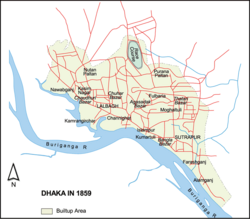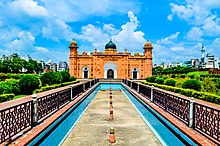Old Dhaka
পুরান ঢাকা | |
|---|---|
![Dhaka City across Buriganga River in a 1861 painting[1]](http://upload.wikimedia.org/wikipedia/commons/thumb/1/1f/DhakaCity1861.png/250px-DhakaCity1861.png) Dhaka City across Buriganga River in a 1861 painting[1] | |
 Map of Old Dhaka during British rule | |
| Coordinates: 23°42′25″N 90°24′34″E / 23.70694°N 90.40944°E | |
| Country | |
| District | Dhaka District |
| City Corporation | Dhaka South City Corporation |
| Settlement | Around 500 BC |
| Establishment | 1608 CE |
| Expansion | After 1910 CE |
Old Dhaka (Bengali: পুরান ঢাকা, romanized: Puran Dhaka) is a term used to refer to the historic old city of Dhaka, the capital of Bangladesh.[2] It was founded in 1608 as Jahangirabad or Jahangirnagar (Bengali: জাহাঙ্গীরনগর, romanized: Jahangirnogor, lit. 'City of Jahangir'), the capital of Mughal Province of Bengal and named after the Mughal emperor Jahangir. It is located on the banks of the Buriganga River. It was one of the largest and most prosperous cities of the Indian subcontinent and the center of the worldwide muslin trade. The then Nawab of Bengal Murshid Quli Khan, later shifted the capital from Dhaka to Murshidabad in the early-18th century. With the rise of Calcutta (now Kolkata) during British rule, Dhaka began to decline and came to be known as the "City of Magnificent Ruins". The British however began to develop the modern city from the mid-19th century.[3]


Old Dhaka is famous for its variety of foods and amicable living of people of all religions in harmony. The main Muslim festivals celebrated with funfair here are Eid-ul-Fitr, Eid-ul-Adha and Ashura,[4] Hindu festivals like Durga Puja,[5] Kali Puja, and Saraswati Puja[6] are also celebrated with enthusiasm. The festivals which are celebrated by all religious communities with much splendor include Shakrain (পৌষ সংক্রান্তি), Pohela Falgun,[7] and Halkhata (হালখাতা). Religion-wise, the old Dhaka is predominantly Muslim, while a significant number of Hindus also reside here. Christians and Buddhists are also inhabitants here in small numbers. Its inhabitants are known as the demonym Dhakaiya.
- ^ "Painting - De Fabeck, Frederick William Alexander". Victoria and Albert Museum. Retrieved 23 January 2018.
- ^ Chowdhury, AM (2012). "Dhaka". In Sirajul Islam; Miah, Sajahan; Khanam, Mahfuza; Ahmed, Sabbir (eds.). Banglapedia: the National Encyclopedia of Bangladesh (Online ed.). Dhaka, Bangladesh: Banglapedia Trust, Asiatic Society of Bangladesh. ISBN 984-32-0576-6. OCLC 52727562. OL 30677644M. Retrieved 19 January 2025.
- ^ "Saving Dhaka's heritage". BBC Travel.
- ^ "Taazia processions held in Dhaka amidst tight security". bdnews24.com. Retrieved 1 March 2017.
- ^ "Durga Puja testifies for religious harmony". Dhaka Tribune. 12 October 2016. Retrieved 1 March 2017.
- ^ "Saraswati Puja tomorrow". Prothom Alo. Retrieved 1 March 2017.
- ^ "Pohela Falgun being celebrated". Dhaka Tribune. Retrieved 2 March 2017.
